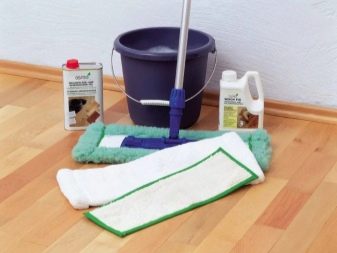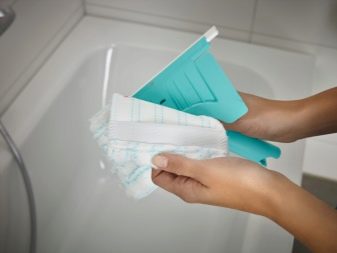Features of microfiber mop attachments
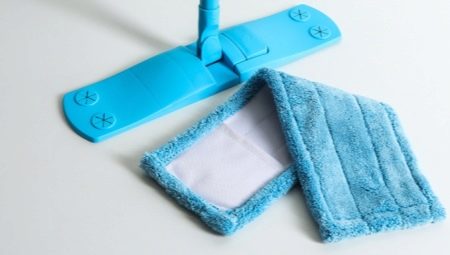
Microfiber - modern synthetic material... Long, porous microfibers made of polyester or polyamide are tightly woven together to create a high-performance fabric. It is ideal for home cleaning as it is excellent at picking up dirt and absorbing moisture.
Advantages and disadvantages
A distinctive feature of these mops is that Microfiber mop attachments are replaceable. It is enough to buy one high-quality mop, and then select several attachments for it, since they may differ in appearance. Also, for each room, you can select a separate device, including for washing the walls.
Microfiber is very soft, while effectively picking up dirt and squeezing well. It is perfect for cleaning parquet and laminate floors. These materials do not like water, as it can spoil them. For wet cleaning, it is enough for the nozzle to be slightly damp. It does not leave streaks, polishing the surface in parallel, which makes microfiber indispensable for marble floors and dark tiles. Drops and streaks are most noticeable on these materials.
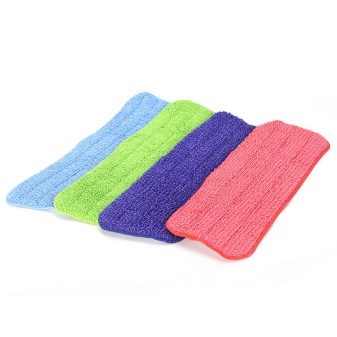

It is important to note that because the microfiber is easily squeezed out, it does not require a lot of water to clean. And the floors themselves, regardless of the coating, dry quickly.
Also, of the advantages, one can single out:
- lightness of the material;
- does not wrinkle, does not fade;
- durability, strength;
- does not cause allergies;
- does not leave streaks;
- attracts dust;
- collects dirt and animal hair efficiently;
- perfectly absorbs moisture, while easily squeezing out;
- can be washed many times;
- suitable for all types of floors;
- used for wet and dry cleaning.
Microfiber is great for cleaning children's rooms. It picks up dirt, dust and pet hair well, but does not cause allergies. If a child is involved in cleaning, then he can easily cope with the attachment, since the material is light and squeezed out without effort.
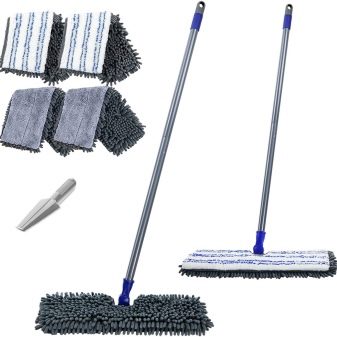
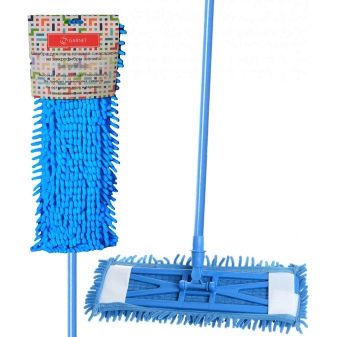
Dry cleaning creates static electricity that attracts dust to the brush head. Therefore, with mops with such attachments, it is convenient to collect dust from the walls, especially from paper wallpaper, which cannot be wetted. She is also good at collecting cobwebs, it can be used to wipe the ceiling plinths. The material is so soft that you can clean stretch ceilings with a microfiber mop. Therefore, you should take care in advance that there is a replaceable nozzle for different purposes.
But there are also disadvantages:
- high price;
- poor resistance to high temperatures;
- accumulating fat, become unusable.
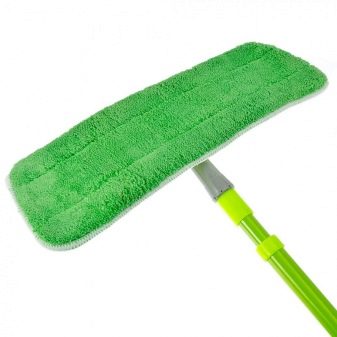
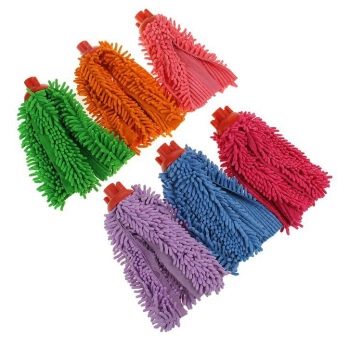
Microfiber does not tolerate high temperatures. Nozzles cannot be boiled, washed at temperatures above 40 degrees Celsius, dried on a heater and a battery. The material will simply melt and become unusable.
Types and models
The market offers a huge selection of microfiber mops. Models often have telescopic handles made of metal or plastic, and a leg, directly to which the attachment is attached. The mop is necessarily included, but you can also purchase it separately. Thus, it is easy to replace the nozzle if necessary or add additional ones for different areas of work.
There are three types of nozzles:
- rectangular;
- triangular;
- round.
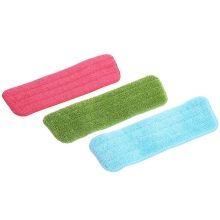
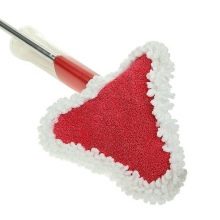
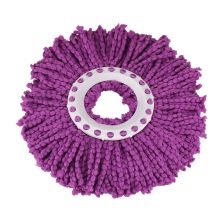
The rectangular butterfly mop is the most popular. Oit has a more classic look, perfectly collects dirt, is flat, thanks to which it gets out debris even from under low furniture. Most often, the size of the flounder is 40 x 11 cm. These are the optimal parameters for home cleaning. There are also larger flounders that are ideal for cleaning large areas.
Mops with round nozzles often come with a bucket and a centrifuge. Outwardly, it resembles a deck mop, but the ropes are microfiber, and the nozzle itself is often attached directly to the handle.
The round nozzle is more versatile, suitable for difficult areas, perfectly picks up dirt from hard-to-reach places.
With triangular attachment models are less popular, but they are excellent at collecting garbage from corners. There are both flat and rope attachments. The latter are shorter, like a "skirt" than round nozzles. Steam mop heads are often triangular.
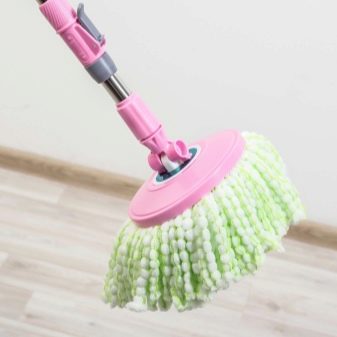
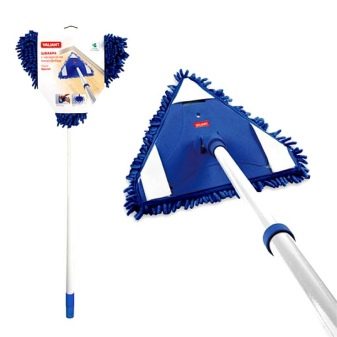
Depending on the surface, they also stand out:
- fluffy;
- with large villi (noodles);
- with loops (tape).
Meet reversible mops with microfiber attachments specially for cleaning carpets.
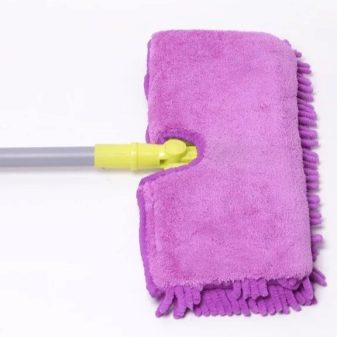
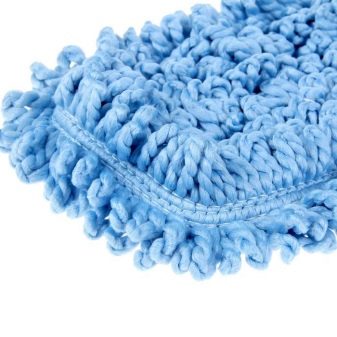
How to use?
For dry cleaning, for example, to brush off the old wallpaper from the wallpaper, just put on a clean nozzle on the mop and run along the walls. If the cover can be washed, the mop should be slightly moistened. Similarly, you can wipe stretch ceilings, but carefully.
If the floor is relatively clean, you only need to wipe it, then you can moisten it with water from a spray bottle and wipe it with a mop. It is recommended to first collect the garbage with a vacuum cleaner. This cleaning method is suitable for parquet floors.
If wet cleaning is required, then the attachment will have to be removed and rinsed. Then put on the flounder. First, on one side, then thread into the other loop and straighten the platform until it clicks. Some housewives got the hang of inserting the mop into the nozzle spread on the floor. If the attachment is with Velcro, then just attach. In any case, the microfiber itself will have to be squeezed out by hand, and if there is a lot of dirt, then rinse it often.
An exception is the belt packing if a centrifuge is included with it. The mop is first lowered into a bucket, and then, pressing, I wring it out in a centrifuge.
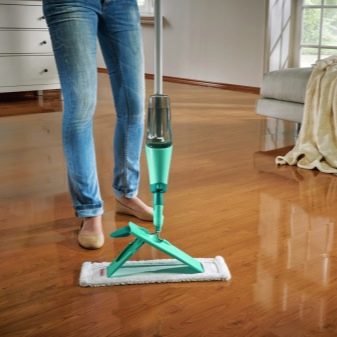
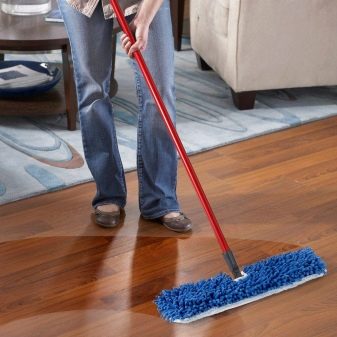
After cleaning, it is recommended not to leave the detachable attachment on the mop. It is rinsed and left to dry. By the way, a mop with microfiber can also wash glass on the balcony from the inside. They are often quite large.And if the apartment is on the ground floor, then wipe them from the street side.
How to care?
Microfiber attachments are easy to clean. To avoid getting dirty, they must be washed. You can use your hands or in a washing machine along with bath rugs or other cleaning rags.
The water temperature should not be higher than 40 degrees Celsius. Any detergent can be used. Although microfiber does not shed, it can easily discolor when exposed to bleach. Therefore, if aggressive substances are used during cleaning, it may well lighten or deteriorate.
